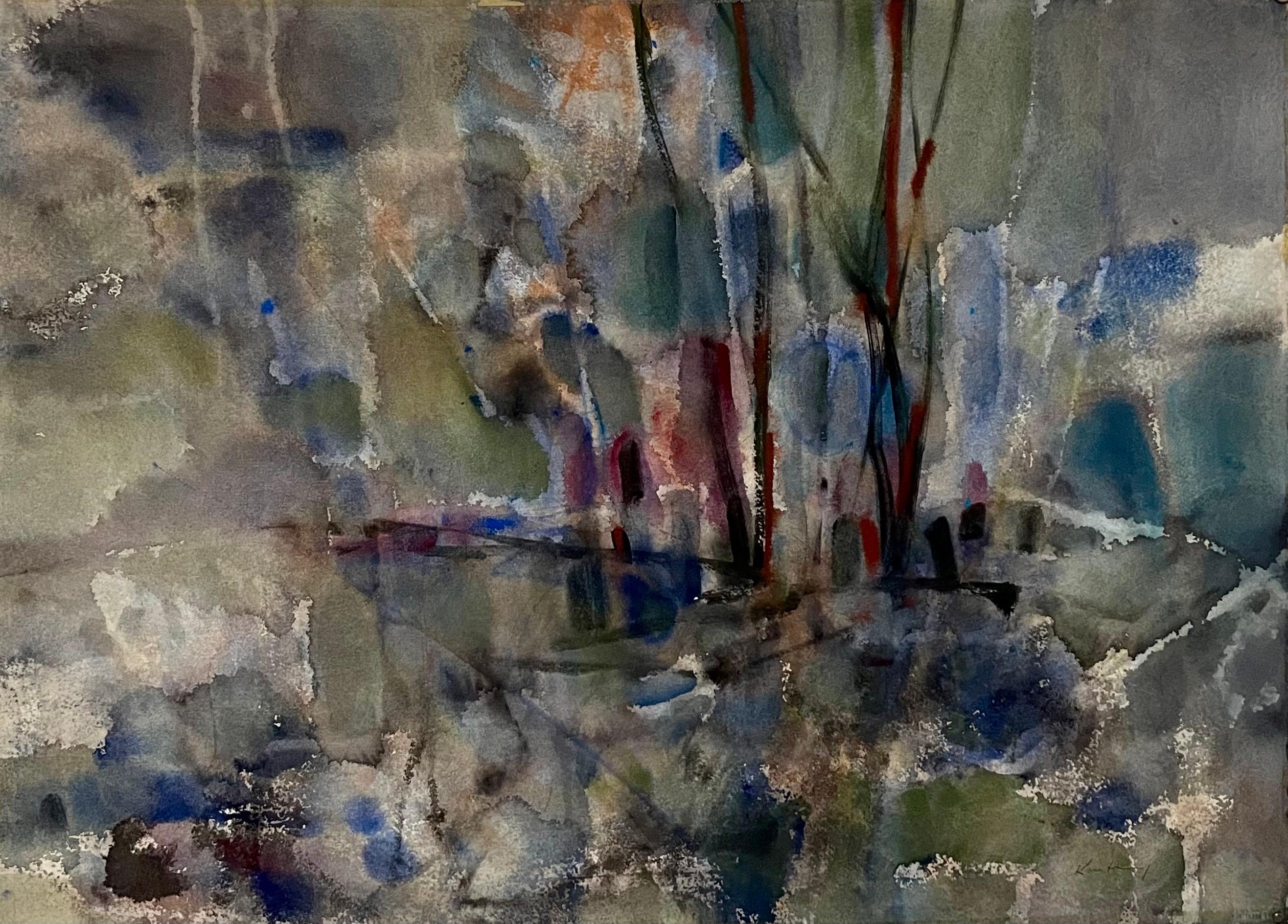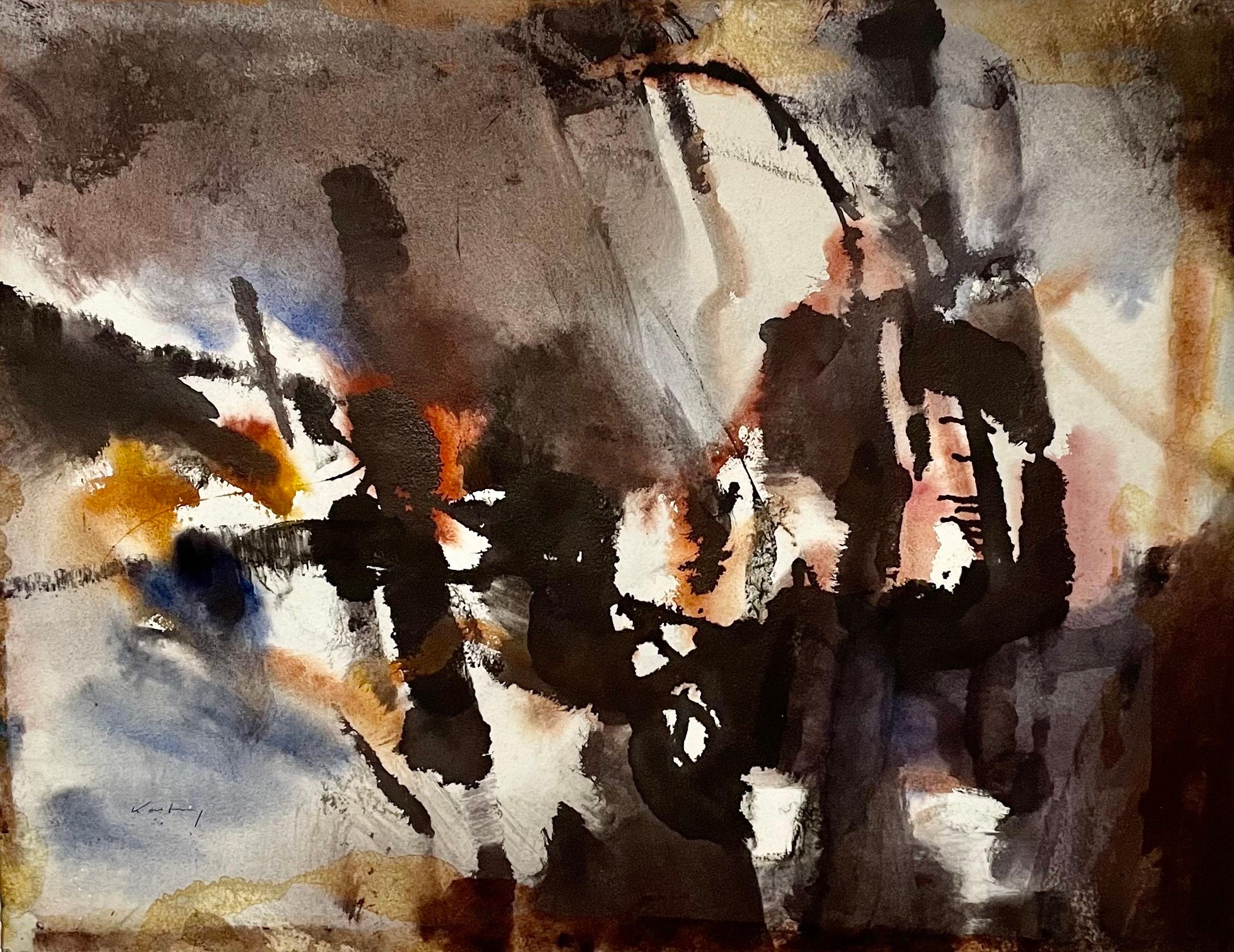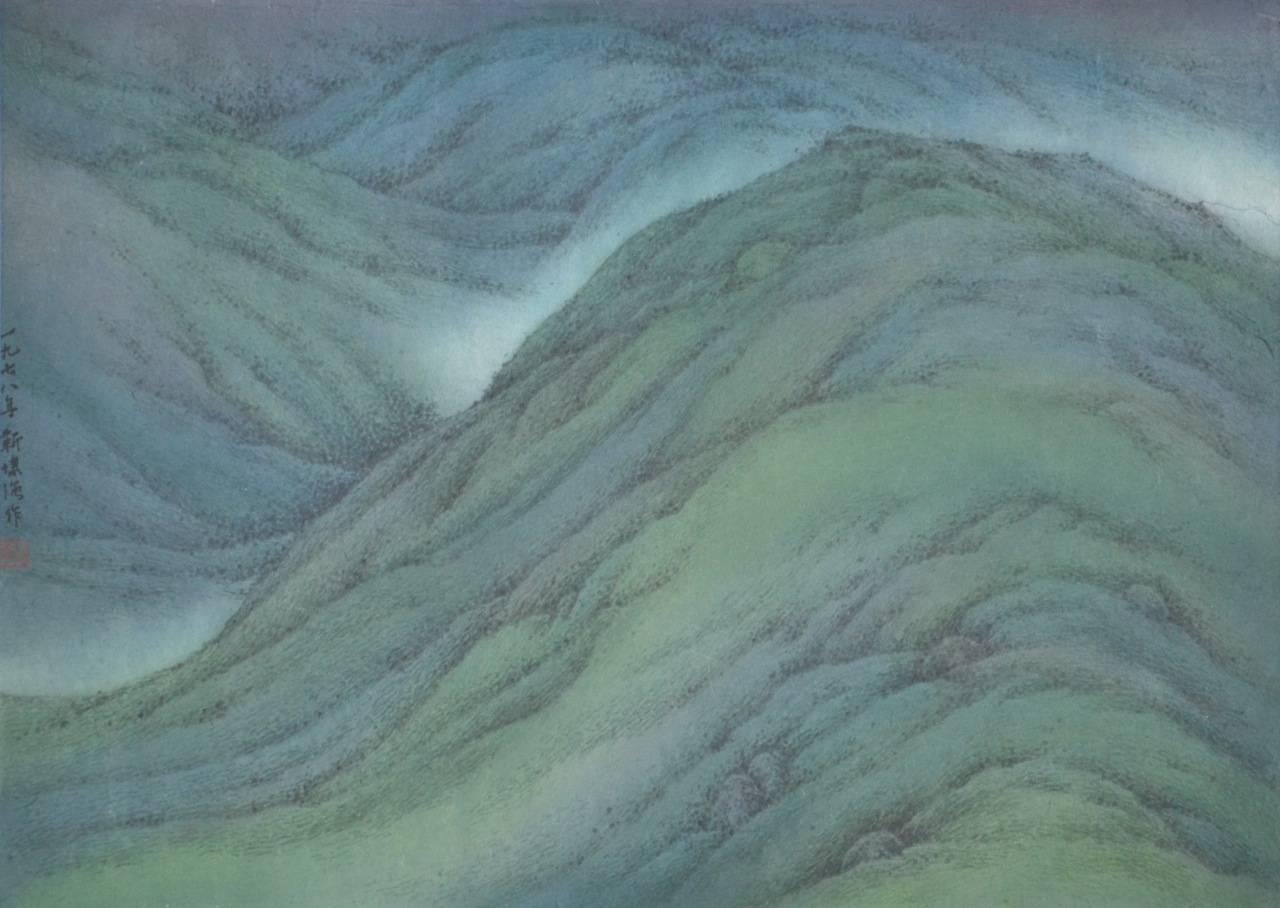Items Similar to Country Lane, Modern British 20th Century Watercolour Landscape
Want more images or videos?
Request additional images or videos from the seller
1 of 2
Peter NewcombeCountry Lane, Modern British 20th Century Watercolour Landscape1973
1973
About the Item
Watercolour on paper, signed and dated '1973' bottom left
Image size: 12 1/2 x 9 1/2 inches (32 x 24 cm)
Contemporary frame
This is a wonderful watercolour of a winter landscape, with a country lane, frost-covered fields and an old farm building. As the artist has worked in his home county for much of his life, this is likely to be a view in rural Northamptonshire.
Peter Newcombe
Newcombe (b.1943) was born in Blisworth, Northamptonshire. He studied illustration and etching at Northampton School of Art, where he won a travelling scholarship. His work first came to public attention in 1968 with a set of twelve large drawings illustrating ‘The Shepherds Calendar’ by John Clare, which were featured on BBC television.
In 1970 he was awarded a major art grant from the Elizabeth T. Greenshield Foundation in Canada. At this time he began exhibiting widely in London including at the Royal Academy, the Royal Society of British Artists, and the Royal Institute of Painters in Watercolour. In 1979 he designed a set of flower stamps for the Post Office.
The subject matter of Peter Newcombe’s paintings is gathered almost entirely from the area of Northamptonshire in which he lives. His paintings are intense studies of landscape and flora in all seasons, and he has a particular interest in old buildings and wild flowers.
- Creator:Peter Newcombe (1943 - 1991, English)
- Creation Year:1973
- Dimensions:Height: 12.5 in (31.75 cm)Width: 9.5 in (24.13 cm)
- More Editions & Sizes:1 of 1 Price: $1,169
- Medium:
- Movement & Style:
- Period:
- Condition:
- Gallery Location:London, GB
- Reference Number:1stDibs: LU52412947072
About the Seller
5.0
Gold Seller
These expertly vetted sellers are highly rated and consistently exceed customer expectations.
Established in 2007
1stDibs seller since 2014
66 sales on 1stDibs
Typical response time: 4 hours
- ShippingRetrieving quote...Ships From: London, United Kingdom
- Return PolicyA return for this item may be initiated within 14 days of delivery.
More From This SellerView All
- St Nicholas Cole Abbey and St Mary Somerset Church, London, The BlitzLocated in London, GBThis drawing records the destruction that was endured by London during the Blitz. The building in the foreground is St Nicholas Cole Abbey, situated in the city of London. Whilst a church was recorded on this site from the twelfth century, this church was destroyed in the Great Fire of London so the remnants of the church that we see here is one that was built by Sir Christopher Wren...Category
Mid-20th Century Modern Landscape Drawings and Watercolors
MaterialsPaper, Watercolor, Graphite
- A River Landscape, 19th Century British Watercolour, Signed and Dated 1880By Alfred EastLocated in London, GBWatercolour on paper, signed and dated '1880' bottom left Image size: 9 x 13 inches (23 x 30 cm) Hand made gilt frame Sir Alfred East Sir Alfred East was born in Kettering, Northa...Category
1880s Modern Landscape Drawings and Watercolors
MaterialsWatercolor
- A View of Riseholme, 18th Century English Signed Watercolour LandscapeLocated in London, GBWatercolour on paper, signed and entitled bottom right Image size: 12 x 10 inches (30.5 x 25.5 cm)Category
18th Century Landscape Drawings and Watercolors
MaterialsWatercolor, Paper
- Castle San Angelo, Rome, David Roberts, 19th Century Original WatercolourBy David RobertsLocated in London, GBPencil, watercolour and bodycolour heightened with white. Image size: 9 1/2 x 13 1/4 inches (24 x 34 cm) Hand made gilt frame Provenance The Fine Art Society 1981 (Label Verso) Priv...Category
Mid-19th Century Victorian Landscape Drawings and Watercolors
MaterialsPaper, Watercolor
- St Mark's Square, Venice, 19th Century French Watercolour, Signed, '1868'Located in London, GBWatercolour on paper, signed and dated '1868' lower right Image size: 16 x 11 1/2 inches (40.5 x 29.25 cm) Mounted The scene represents the edge of the piazza at St Mark's Square i...Category
1860s French School Landscape Drawings and Watercolors
MaterialsPaper, Watercolor
- The Boat Yard, 20th Century English Watercolour and Graphite ArtworkBy William DringLocated in London, GBWatercolour and graphite on paper Image size: 15 1/4 x 11 1/4 inches (38.75 x 28.5 cm) This wonderful 20th century watercolour painting depicts a small boat yard that is filled with...Category
20th Century Landscape Drawings and Watercolors
MaterialsPaper, Watercolor, Graphite
You May Also Like
- Landscape - Drawing by Jean-Raymond Delpech - Mid-20th centuryBy Jean DelpechLocated in Roma, IT"Landscape" is an original drawing in watercolor on paper, realized by Jean-Raymond Delpech (1916-1988). The state of preservation of the artwork is good and aged with some ripping ...Category
Mid-20th Century Modern Landscape Drawings and Watercolors
MaterialsWatercolor, Paper
- Landscape - Watercolor - Early 20th CenturyLocated in Roma, ITLandscape is an original drawing in watercolor on paper realized by an unknown artist of the 19th Century. Hand-signed on the lower right, the signature is illegible. The state o...Category
Early 20th Century Modern Landscape Drawings and Watercolors
MaterialsWatercolor, Paper
- Modernist Abstract Expressionist Watercolor Painting Bauhaus Weimar Pawel KontnyBy Pawel KontnyLocated in Surfside, FLAbstract watercolor composition bearing the influence of the earlier color-block compositions of Paul Klee. Pawel August Kontny, (Polish-German-American artist) He was born in Laurahuette, Poland, in 1923, the son of a wealthy pastry shop owner. In 1939 he began studying architecture in Breslau where he was introduced to the European masters and to the work of some of the German Expressionists, soon afterward banned as "degenerate artists" and removed from museums throughout Germany by the Nazi regime. His studies were interrupted by World War II. Drafted into the German army, traveling in many countries as a soldier, he sketched various landscapes but in 1945, he was captured and held as a prisoner of war in Italy. After the war, he studied at the Union of Nuremberg Architects to help design buildings to replace ones destroyed in the war. He recorded his impressions of the local population and the landscapes through his watercolors and drawings. Pawel Kontny thereafter moved to Nuremberg, Germany, becoming a member of the Union of Nuremberg Architects and helping to rebuild the city's historic center. He soon decided to concentrate on his professional art career. He married Irmgard Laurer, a dancer with the Nuremberg Opera. Pavel Kontny 's career as an artist was launched with his participation in an all German exhibition, held at the Dusseldorf Museum in 1952. He held one-man shows in Germany, Switzerland and the United States. During his trip to the United States in 1960, Kontny became instantly enamored with Colorado, and decided to relocate to Cherry Hills with his wife and two children. He quickly established himself in the local art community, being affiliated for a time with Denver Art Galleries and Saks Galleries. His subject matter became the Southwest. During this time he received the Prestigious Gold Medal of the Art Academy of Rome. His extensive travel provided material for the paintings he did using his hallmark marble dust technique. he also worked equally in pastel, watercolor, charcoal and pencil-and-ink. in a style which merged abstraction and realist styles, influenced by Abstract Expressionist painting and South Western American landscapes. This one bears the influence of Sam Francis. In the early 1960s he was one of only a few European-born professional artists in the state, a select group that included Herbert Bayer (1900-1985), a member of the prewar Bauhaus in Weimar and Dessau, Germany, and Roland Detre (1903-2001), a Hungarian modernist painter. As a Denver, Colorado resident, Pavel Kontny exhibited at galleries and museums throughout the United States, Germany and Japan. There, he was inspired by frequent trips to Native American pueblos in the Southwest, as well as by the study of the Plains Indians of Montana and Wyoming. Over the years Kontny had a number of students and generously helped young artist by hosting exhibitions at his Cherry Hills home. For many years he generously donated his paintings to support charitable causes in Denver. Influences during his European years included German pastelist C.O. Muller, German Informel painter Karl Dahmen and Swiss artist, Hans Erni. In the early 1950s his painting style showed the influence of the Die Brücke (The Bridge), a group of German expressionist artists formed in Dresden in 1905 who had a major impact on the evolution of modern art in the twentieth century in Germany. By the middle of the decade his style incorporated more referential abstraction and total abstraction, resulting in part from his study of Hans Hartung, a German artist based in Paris who exhibited his gestural abstract work in Germany. The American moon landing in 1969 inspired Paul Kontny...Category
20th Century American Modern Abstract Drawings and Watercolors
MaterialsWatercolor, Archival Paper
- Modernist Abstract Expressionist Watercolor Painting Bauhaus Weimar Pawel KontnyBy Pawel KontnyLocated in Surfside, FLAbstract watercolor composition bearing the influence of the earlier color-block compositions of Paul Klee. Pawel August Kontny, (Polish-German-American artist) He was born in Laurahuette, Poland, in 1923, the son of a wealthy pastry shop owner. In 1939 he began studying architecture in Breslau where he was introduced to the European masters and to the work of some of the German Expressionists, soon afterward banned as "degenerate artists" and removed from museums throughout Germany by the Nazi regime. His studies were interrupted by World War II. Drafted into the German army, traveling in many countries as a soldier, he sketched various landscapes but in 1945, he was captured and held as a prisoner of war in Italy. After the war, he studied at the Union of Nuremberg Architects to help design buildings to replace ones destroyed in the war. He recorded his impressions of the local population and the landscapes through his watercolors and drawings. Pawel Kontny thereafter moved to Nuremberg, Germany, becoming a member of the Union of Nuremberg Architects and helping to rebuild the city's historic center. He soon decided to concentrate on his professional art career. He married Irmgard Laurer, a dancer with the Nuremberg Opera. Pavel Kontny 's career as an artist was launched with his participation in an all German exhibition, held at the Dusseldorf Museum in 1952. He held one-man shows in Germany, Switzerland and the United States. During his trip to the United States in 1960, Kontny became instantly enamored with Colorado, and decided to relocate to Cherry Hills with his wife and two children. He quickly established himself in the local art community, being affiliated for a time with Denver Art Galleries and Saks Galleries. His subject matter became the Southwest. During this time he received the Prestigious Gold Medal of the Art Academy of Rome. His extensive travel provided material for the paintings he did using his hallmark marble dust technique. he also worked equally in pastel, watercolor, charcoal and pencil-and-ink. in a style which merged abstraction and realist styles, influenced by Abstract Expressionist painting and South Western American landscapes. This one bears the influence of Sam Francis. In the early 1960s he was one of only a few European-born professional artists in the state, a select group that included Herbert Bayer (1900-1985), a member of the prewar Bauhaus in Weimar and Dessau, Germany, and Roland Detre (1903-2001), a Hungarian modernist painter. As a Denver, Colorado resident, Pavel Kontny exhibited at galleries and museums throughout the United States, Germany and Japan. There, he was inspired by frequent trips to Native American pueblos in the Southwest, as well as by the study of the Plains Indians of Montana and Wyoming. Over the years Kontny had a number of students and generously helped young artist by hosting exhibitions at his Cherry Hills home. For many years he generously donated his paintings to support charitable causes in Denver. Influences during his European years included German pastelist C.O. Muller, German Informel painter Karl Dahmen and Swiss artist, Hans Erni. In the early 1950s his painting style showed the influence of the Die Brücke (The Bridge), a group of German expressionist artists formed in Dresden in 1905 who had a major impact on the evolution of modern art in the twentieth century in Germany. By the middle of the decade his style incorporated more referential abstraction and total abstraction, resulting in part from his study of Hans Hartung, a German artist based in Paris who exhibited his gestural abstract work in Germany. The American moon landing in 1969 inspired Paul Kontny...Category
20th Century American Modern Abstract Drawings and Watercolors
MaterialsWatercolor, Archival Paper
- Modernist Abstract Expressionist Watercolor Painting Bauhaus Weimar Pawel KontnyBy Pawel KontnyLocated in Surfside, FLAbstract watercolor composition bearing the influence of the earlier color-block compositions of Paul Klee. Pawel August Kontny, (Polish-German-American artist) He was born in Laurahuette, Poland, in 1923, the son of a wealthy pastry shop owner. In 1939 he began studying architecture in Breslau where he was introduced to the European masters and to the work of some of the German Expressionists, soon afterward banned as "degenerate artists" and removed from museums throughout Germany by the Nazi regime. His studies were interrupted by World War II. Drafted into the German army, traveling in many countries as a soldier, he sketched various landscapes but in 1945, he was captured and held as a prisoner of war in Italy. After the war, he studied at the Union of Nuremberg Architects to help design buildings to replace ones destroyed in the war. He recorded his impressions of the local population and the landscapes through his watercolors and drawings. Pawel Kontny thereafter moved to Nuremberg, Germany, becoming a member of the Union of Nuremberg Architects and helping to rebuild the city's historic center. He soon decided to concentrate on his professional art career. He married Irmgard Laurer, a dancer with the Nuremberg Opera. Pavel Kontny 's career as an artist was launched with his participation in an all German exhibition, held at the Dusseldorf Museum in 1952. He held one-man shows in Germany, Switzerland and the United States. During his trip to the United States in 1960, Kontny became instantly enamored with Colorado, and decided to relocate to Cherry Hills with his wife and two children. He quickly established himself in the local art community, being affiliated for a time with Denver Art Galleries and Saks Galleries. His subject matter became the Southwest. During this time he received the Prestigious Gold Medal of the Art Academy of Rome. His extensive travel provided material for the paintings he did using his hallmark marble dust technique. he also worked equally in pastel, watercolor, charcoal and pencil-and-ink. in a style which merged abstraction and realist styles, influenced by Abstract Expressionist painting and South Western American landscapes. This one bears the influence of Sam Francis. In the early 1960s he was one of only a few European-born professional artists in the state, a select group that included Herbert Bayer (1900-1985), a member of the prewar Bauhaus in Weimar and Dessau, Germany, and Roland Detre (1903-2001), a Hungarian modernist painter. As a Denver, Colorado resident, Pavel Kontny exhibited at galleries and museums throughout the United States, Germany and Japan. There, he was inspired by frequent trips to Native American pueblos in the Southwest, as well as by the study of the Plains Indians of Montana and Wyoming. Over the years Kontny had a number of students and generously helped young artist by hosting exhibitions at his Cherry Hills home. For many years he generously donated his paintings to support charitable causes in Denver. Influences during his European years included German pastelist C.O. Muller, German Informel painter Karl Dahmen and Swiss artist, Hans Erni. In the early 1950s his painting style showed the influence of the Die Brücke (The Bridge), a group of German expressionist artists formed in Dresden in 1905 who had a major impact on the evolution of modern art in the twentieth century in Germany. By the middle of the decade his style incorporated more referential abstraction and total abstraction, resulting in part from his study of Hans Hartung, a German artist based in Paris who exhibited his gestural abstract work in Germany. The American moon landing in 1969 inspired Paul Kontny...Category
20th Century American Modern Abstract Drawings and Watercolors
MaterialsWatercolor, Archival Paper
- Spring Mountain 1978 Modern Chinese WC Sumi Painting blue green contemporaryBy Kan Tai-KeungLocated in Rancho Santa Fe, CAThis painting is illustrated in color in the the book, "PAINTINGS BY KAN TAI-KEUNG 1970-1979" page 51. Published by S S Design & Production, Hong Kong, 1980. A copy of this book will accompany the painting. Born in Panyu, Guangdong, in 1942, Kan Tai-Keung was deeply influenced by his grandfather, Yao Sheung, and became passionate about painting from childhood on. He moved to Hong Kong in 1957, and worked as an apprentice tailor there for ten years. In 1964, Kan started to learn watercolour painting and sketching with his uncle Han May-Tin. Later he took a Chinese ink painting course from Lui Shou-kwan and an applied design course from Wucius Wong...Category
1970s Modern Landscape Drawings and Watercolors
MaterialsSumi Ink, Watercolor, Mulberry Paper
Recently Viewed
View AllMore Ways To Browse
Large Landscape Drawing
British Country
Large Landscape Watercolor
Large Landscape Watercolour
Modern British School
20th Century British Landscapes
British Modern Painters
Landscape Drawings Flowers
Artist Lane
Vintage British Stamp
Set Of 12 Drawings
Canadian Landscape Drawings
Modern Rural Landscape
Large British Painting Modern
Flower Drawing Large
Watercolor Set Of 2
Large Farm Landscapes
Retro Television Sets





